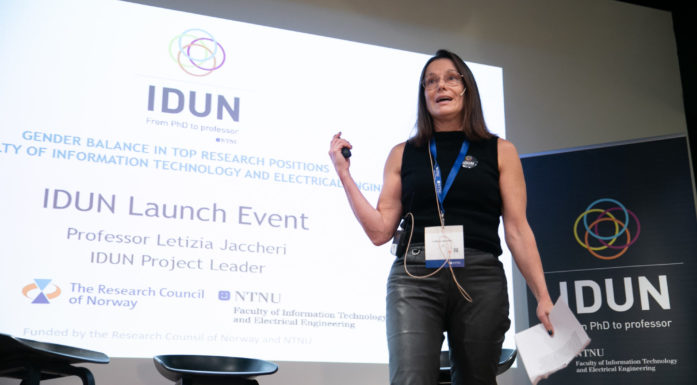It's 1910 and NTH, the Norwegian Institute of Technology, is officially opening. The hall is full of men, aside from a woman in the back, against the wall. Photo: Fredrik Hilfling-Rasmussen/NTNU University Library
How chemistry studies became a door opener for women in 1910
The Norwegian Institute of Technology had special status and an education from the institute virtually guaranteed good career opportunities. The door opened for women to break the glass ceiling in the early 20th century and become chemical engineers. But every woman needed a supportive man behind her.
By Ingebjørg Hestvik - Published 13.06.2023
It's a festive day in Trondheim. King Haakon is present. Schools and shops are closed and Norwegian flags fly over the city. It is September 1910 and Norway's Institute of Technology (NTH) at Gløshaugen in Trondheim is about to be inaugurated with its first cohort of students.
Over a hundred students, professors and staff as well as invited guests, all men, sit close together. Everyone turns to the photographer as the historic moment is immortalized.
Farthest away, standing by the wall, one can make out a young woman. Her name is Aslaug Urbye, Norway's first female civil engineering student.
“Urbye only studied for a year and a half before she discontinued her studies.” She stated that she quit because of an eye disease, but Annette Lykknes wondered if that was the only reason.
Lykknes is a science historian and also has a background in chemistry. She took her doctorate on radiochemistry pioneer Ellen Gleditsch, Norway's second female professor and colleague of Nobel Prize winner Marie Curie. Gleditsch’s work contributed to establishing the half-life of the radioactive metal radium.

Science historian Annette Lykknes. Photo: Ingebjørg Hestvik
Uncomfortable entering the lecture hall
Lykknes sits and studies the picture of the packed auditorium in Trondheim, with a lone woman standing by the wall.
Who was she? And who were the first women to choose to study at NTH? What motivated them to study industrial chemistry? What career opportunities did they have, and to what extent were they helped along the way by mentors?
“I became very curious about this girl, Aslaug Urbye,” says Lykknes, “and I managed to get in touch with a relative of hers. He had a report written by an engineer who had lived with Urbye at Rjukan. She had told him that it was uncomfortable to enter the lecture hall at NTH. The other students started making scraping noises with their chairs as soon as she entered the room.”
Aslaug Urbye was born in 1889 and must have been very interested in studying industrial chemistry. She started her studies at the Royal Frederick University (University of Oslo) after being refused admission to the Kristiania Technical School in 1907 on the grounds that she was a woman. In 1909 she became a laboratory assistant at Norsk Hydro in Notodden and then at Notodden Salpeterfabrikk. In 1910, she was admitted to NTH as the only woman in the entire institute. She married in 1912, had five sons and lived most of her life near Rjukan, where her husband helped establish Norsk Hydro's saltpetre factory.
Photo: Fredrik Hilfling-Rasmussen/NTNU University Library
Studied the lives of 16 female students at NTH
Curiosity about the lone young woman in the banquet hall led Lykknes to research the stories of the first female chemistry students at NTH.
“I found a collection of biographies about the first ten cohorts of engineers from NTH. Urbye is mentioned there as the only one who did not have a beard. There were no other women at NTH at the time, nor any secretaries. That picture of her is a really powerful photo," she said.
Lykknes chose to take a closer look at 16 of the first female chemistry students to complete their education. She has studied the lives and careers of three of them in detail, each representing one of three different branches of industry in Norway at the beginning of the last century.
“NTH's very special position as an educational institution during this period led many women with ambition to choose a career in the chemical industry,” says Lykknes.
When NTH opened in 1910, Norway was in the midst of rapid industrial development with the development of hydropower and, in addition, the development of the power-intensive electrochemical industry. NTH's task was to educate engineers who would contribute to this development, and the institute was considered central to building a new independent Norway.
“The expertise gained at NTH was associated with high prestige. This led to women being able to break barriers that they encountered in Norwegian society at the beginning of the 20th century,” says Lykknes.
Margot Dorenfeldt (1895-1986) graduated from NTH in 1919: Her father was trained as an engineer in Germany, and her mother had studied chemistry at the Trondhjem Technical Institute. In 1920, Dorenfeldt became a lecturer at the Royal Frederick University (University of Oslo) where she researched the atomic weight of the element chlorine (Cl). For short periods she worked as deputy chief chemist at Tofte cellulose factory together with her husband Eugen Holtan (also a chemist). In 1946, she was employed by the Ministry of Industry, where she later became a bureau clerk f for the Wood Processing Office.
Photo: NTNU University Library
Important to have a mentor as door opener
The most important thing needed to succeed as a female chemical engineer in the early 20th century was to have a mentor. Most often this was a father or a husband, but it could also be a professor who supported his student and helped her get a foothold in the chemical industry or other work.
“The classic situation having a father who was an engineer, and many of these women had that. It often meant that they were supported in their educational choice. They also became familiar with the profession and knew what it entailed. A father could also contribute with important contacts,” says Lykknes.
Lykknes says it was crucial for the mentor to have a position in industry.
“Having a position meant much more than working together with renowned international researchers. This was the case with Ellen Gleditsch. The fact that Gleditsch was in the circle of Nobel Prize winner Marie Curie had little significance for her further career at home in Norway. The most important thing was to receive support from a man who had a position in the industry,” says Lykknes.
Jørgine Stene (Sørensen) (1905-1997)
Jørgine Stene (Sørensen) (1905-1997) graduated from NTH in 1929. For several years she was a research assistant in technical-organic chemistry at NTH, where she studied vitamin A in fish. Later she became a chemist at the Nidar chocolate factory (established in 1912). Among other things, she helped develop the Stratos chocolate bar. When her husband Nils Andreas Sørensen became professor of chemistry at NTH, she quit the chocolate factory to work with him. In 1938 they travelled to Heidelberg to work with Richard Kuhn, who the following year received the Nobel Prize in Chemistry. Stene Sørensen studied the substance astaxanthin here, known for giving salmon and lobster their characteristic red colour.
Photo: Schrøder/Trøndelag folk museum
After the Second World War, Stene Sørensen worked with her husband at NTH, where they researched naturally occurring acetylene compounds in the Compositae plant family. Photo: Nils Lystad
Women expected to drop their career when they married
Lykknes emphasizes the strong will to succeed that these first women had.
“They really wanted this. The vast majority of women who graduated worked for a period in industry. They lived in a time where the expectation was that women should step back when they married, and women who married another researcher often did not get paid, independent positions. However, they were given access to laboratories and to colleagues, and they were given independent tasks.”
Liv Ranfrid Tessem
Liv Ranfrid Tessem began studying at NTH in 1924. After her studies, she was hired at a local smelter, owned by her professor in metallurgy, Harald Pedersen. The factory later became part of the Ila and Lilleby smelter. Tessem worked with analyses of raw materials such as quartz and iron ore. From 1953 on she worked at NTH's laboratory for materials testing.
Tessem never married, a common feature of the majority of women who stayed in the chemical industry for several years.
Photo: NTNU University Library and Schrøder/Trøndelag folk museum
"Reference
Annette Lykknes ”Enabling Circumstances: Women Chemical Engineers at the Norwegian Institute of Technology, 1910-1943”
MORE NORWEGIAN SCITECH NEWS

LOADING CONTENT



